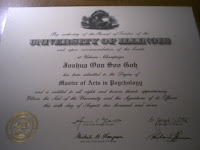


As part of the lab shift to Dallas, we went down to check it out in the Lone Star state. I shun bian say hello to Mei. There are several ways to get to Dallas from Champaign. Drive = 12 hrs, Direct 6am flight from CMI airport to DFW airport = 2 hrs, mid-day flights with transit from CMI-ORD-DFW = 4hrs, staying put = priceless. Anyway, we took option number 3 and, as you can see, we start out strong. The flight was pretty good, from ORD to DFW, we got personal TV units, slightly larger plane. But then at touchdown, we had to wait pretty long for luggage, because it was such a big flight. Then we wait for Mr Hebrank to come pick us up after his game of Ultimate.
 The car rental place is a 7 min shuttle bus ride from the terminal itself. And once you arrive there, its a humungous air-conned art museum, with car rental outlets just lined up for you to choose. Our Ultimate man came by, we rented an SUV, and drove to our hotel, Embassy Suites at Lovefield, Dallas. We then quickly got ready for dinner with Mei and John. Which was at a nearby steakhouse.
The car rental place is a 7 min shuttle bus ride from the terminal itself. And once you arrive there, its a humungous air-conned art museum, with car rental outlets just lined up for you to choose. Our Ultimate man came by, we rented an SUV, and drove to our hotel, Embassy Suites at Lovefield, Dallas. We then quickly got ready for dinner with Mei and John. Which was at a nearby steakhouse.It was nice to catch up again. And it was fun to have the lab people along too.
After which, we checked into our huge room in the Embassy Suites.

 The next day, we went to the Brain Health Center, which is just a few minutes away. Very impressive building. Very artsy. Definitely a good place to work. Right now, the lab space is still under construction, but when its done, it will be awesome.
The next day, we went to the Brain Health Center, which is just a few minutes away. Very impressive building. Very artsy. Definitely a good place to work. Right now, the lab space is still under construction, but when its done, it will be awesome.
 After that we went to where the scanner is at the hospital. Also another artsy building. We got some scans done, and then, for us, we had to head back to good ole Chambana.
After that we went to where the scanner is at the hospital. Also another artsy building. We got some scans done, and then, for us, we had to head back to good ole Chambana.So of course, what would flying be if there were no delays? So they introduced a little 1 1/2 hr delay for us at DFW. But otherwise, the flight was ok. Got back...showered. And bed = priceless.
Check out the rest of the pictures by clicking here.
Oh yeah...this has got to be the best introduction ever...



 pampered. Wake up to lots of fruits! Very healthy breakfast. And then, its off back to Taipei.
pampered. Wake up to lots of fruits! Very healthy breakfast. And then, its off back to Taipei.




 Some of you may or may not be aware (what kind of stupid statement is that anyway?), that I went to Japan for holiday. Shiokanaden! Subarashi! Hontoni hontoni! The food is good. The service is great. The people are gentle, and ...interesting. The sights and sounds are captivating. And did I mention the food is good? I never bluff.
Some of you may or may not be aware (what kind of stupid statement is that anyway?), that I went to Japan for holiday. Shiokanaden! Subarashi! Hontoni hontoni! The food is good. The service is great. The people are gentle, and ...interesting. The sights and sounds are captivating. And did I mention the food is good? I never bluff.
































